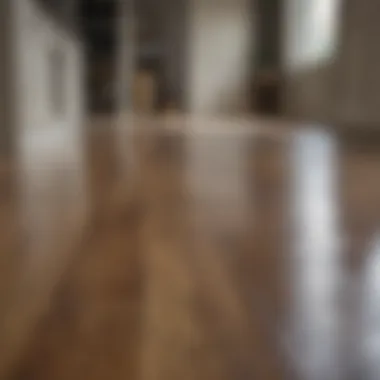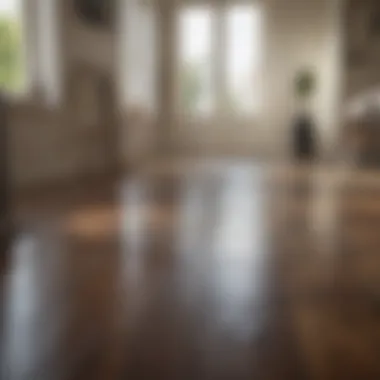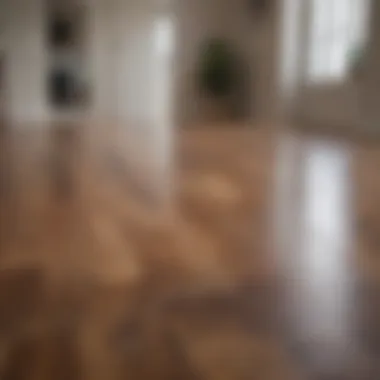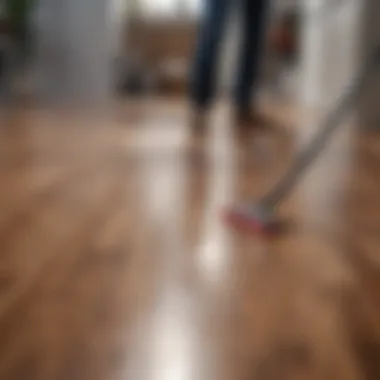Expert Tips for Cleaning Laminate Floors Effectively


Intro
Laminate flooring can transform a home into an elegant abode without breaking the bank. Known for its versatility and affordability, laminate floors are a go-to choice for many homeowners, from cozy apartments to sprawling family homes. However, just like an artist maintains their canvas, proper upkeep is essential to protect this flooring's beauty and usability.
Maintaining laminate floors involves more than just sweeping now and then. Recognizing the right cleaning methods, tools, and products is crucial to deter wear and tear over time. This guide will articulate the nitty-gritty of keeping your laminate floors looking spick and span. From the best techniques to tackle stubborn stains to an overview of necessary cleaning supplies, we’ve got you covered. Let’s delve into the world of laminate floor maintenance and ensure that your home remains a sparkling display of sophistication.
Understanding Laminate Flooring
When you step into a home with laminate flooring, it’s not just about the aesthetics; it’s also about functionality. Understanding what laminate flooring is can significantly help homeowners and property managers maintain it better, ensuring its longevity and sustained beauty. This section delves into the core aspects of laminate flooring, shedding light on its composition, benefits, and common misconceptions, setting the stage for effective cleaning strategies.
What is Laminate Flooring?
At its essence, laminate flooring is a multi-layer synthetic product designed to mimic the appearance of wood, stone, or other natural materials. It comprises four essential layers: the backing layer provides stability, the core layer adds durability, the design layer features high-resolution imaging of natural materials, and finally, a protective wear layer guards against scratches and stains. This construction offers the charm of traditional flooring without the hefty price tag or maintenance headaches associated with materials like hardwood.
Benefits of Laminate Floors
Cost-effectiveness
The affordability of laminate flooring is one of its hallmark attractions. Despite not being the cheapest option available, the overall value it provides is hard to overlook. Homeowners can obtain the look of hardwood floors without spending a fortune. Moreover, the installation costs can be further minimized since many types come with a click-lock mechanism, making it easier to install without professional help. This aspect makes it particularly appealing for those who want a stylish home on a budget.
Durability
Laminate floors are often hailed for their robust performance. Thanks to their top-of-the-line wear layer, they resist scratches, dents, and fades, which is especially beneficial for homes with pets or children. Just remember, while durable, laminate is not indestructible; heavy furniture can still cause impressions if not managed well. Yet overall, its ability to withstand daily wear and tear makes it a favored choice among busy households.
Variety of designs
Another significant aspect of laminate flooring is its aesthetic flexibility. With numerous styles and textures available, from rustic wood grains to sleek stones, homeowners can find options that align with their design vision. This variety enables individuals to express their unique tastes without the limitations that typically accompany traditional flooring materials. However, it’s important to select styles that complement the overall theme of your home, avoiding mismatched designs that could disrupt the flow.
Common Misconceptions
There are several myths surrounding laminate flooring. Many people presume it’s susceptible to moisture damage. While it’s true that standing water can wreak havoc, modern laminate is engineered to handle occasional spills more effectively than its predecessors. Another common belief is that laminate flooring is less visually appealing than natural wood; this is far from the truth. Advances in technology have produced laminate that effectively replicates the nuanced textures and colors of authentic materials.
Understanding these facts is essential as it helps in making informed decisions regarding maintenance and sourcing the right cleaning materials to keep laminate floors looking pristine. By shedding light on what laminate flooring truly is, its myriad benefits, and dispelling common myths, we prepare the reader for a fitting cleaning strategy that preserves both the look and longevity of their investment.
Preparation for Cleaning
Preparing for the cleaning of laminate floors is more than just a prelude to the actual scrubbing; it sets the stage for a successful and efficient cleaning process. Understanding the current state of your flooring and gathering the right tools not only ensures the cleaning is effective but can also prevent further damage to the delicate surface of your laminate. The old adage, "A penny saved is a penny earned," can easily apply here: by putting in the effort ahead of time, you're likely to save yourself both time and money in the long run.
Assessing Your Floor’s Condition
Before diving into the cleaning process, you should assess the condition of your laminate floors. This means taking a good look at any areas that may need special attention. Look for scratches, stains, or signs of water damage. If you notice many scrapes, a gentle touch might be necessary to avoid exacerbation. If water spots are evident, a swift resolution is key to maintaining the floor's beauty.
Knowing your starting point can really help you decide what products to use or what methods to apply. For example, if you see a lot of dirt build-up, you might need to adjust your cleaning strategy.
Gathering Necessary Supplies
Getting your supplies ready is like preparing for a big show—you want everything at your fingertips. With laminate floors, having the right tools can make all the difference:
Broom and Dustpan


A broom and dustpan are staples in any cleaning arsenal. This duo is crucial for the initial step of dry cleaning your floors before any wet cleaning occurs. A soft-bristled broom will do wonders in collecting dust and debris without scratching the surface of the laminate.
The dustpan's contour must also allow for a seamless collection of dirt without leaving remnants behind. If your pan does not sit flush against the ground, you could be leaving particles that can accumulate over time, leading you to more extensive cleaning later.
Mop and Bucket
Once the loose dirt is out of the picture, a mop and bucket become your best touch-ups. When choosing a mop, look for one designed specifically for laminate floors—this helps avoid excess water that could seep into the seams.
An important character of the mop is its ability to pick up grime while being gentle on your floor. A well-balanced mop distributes the right amount of cleaner without saturating the material beneath it.
Laminate-Specific Cleaner
Using the right cleaner is vital. A laminate-specific cleaner is formulated to target grime without scoring the synthetic surface. These cleaners often include solutions that fight against stains while being streak-free. Their unique enzyme-based ingredients not only cut through greasy spots but also condition the floor, extending its lifespan.
Avoid using generalized household cleaners as they might leave residues or dull your laminate finish. A good laminate cleaner will be your unsung hero in maintaining the allure of your floors for an extended period.
Safety Precautions
Although cleaning laminate floors involves simple tools and solutions, neglecting safety can lead to mishaps. Ensure there is always good ventilation when using any cleaning solutions. Make sure to check for any slippery spots after mopping, as water residue can create hazards. Consider wearing gloves if you have sensitive skin, especially when handling concentrated cleaners. Additionally, make an effort to remove any obstacles in the cleaning area to prevent accidents like tripping or falling.
Taking these precautions not only protects your well-being but also helps keep your floor intact, allowing you to appreciate its elegance for a long time.
Cleaning Methods
Cleaning methods for laminate floors form the backbone of proper maintenance. Understanding the varied techniques and their benefits is essential to maintain not just the cleanliness of the surface but its longevity as well. Using the right cleaning strategies ensures that the floor maintains its elegant shine while avoiding scratches or damage that can arise from improper practices.
Dry Cleaning Techniques
Using a microfiber mop
Microfiber mops have garnered a reputation in the cleaning world for good reason. One major aspect of using a microfiber mop is its ability to trap dirt and dust effectively. Unlike traditional mops, which can push dirt around, microfiber mops grasp particles due to their electrostatic properties. This unique feature means you can quickly remove debris from your laminate floors without using harsh chemicals, making it a healthier option for your home as well.
The lightweight nature of microfiber mops allows for easy maneuvering. High-quality microfiber mops can go under furniture and reach corners with minimal effort, which is a notable benefit. However, one downside is that they might need to be washed frequently to maintain their effectiveness; otherwise, they could rediscover and deposit dirt back onto the surface.
Benefits of dusting
Dusting is a basic yet highly effective cleaning technique that should never be overlooked. Regular dusting helps minimize the amount of dirt that can accumulate on your laminate surfaces. It's a beneficial practice because it not only keeps the floors looking their best but also reduces allergens in the environment.
Additionally, the light effort involved in dusting makes it an easy part of your routine. Unlike mopping, which requires water and cleaning solutions, dusting just needs a clean cloth or duster.
Its main limitation, however, is that it may not remove stuck-on stains or grime, so it should be viewed as a part of a more comprehensive cleaning approach.
Wet Cleaning Techniques
Choosing the right cleaner
Selecting the proper cleaner for laminate floors is paramount for maintaining their finish and shine. Many available options sponsor specific ingredients that can effectively clean the surface without causing harm. One key consideration is to avoid products with ammonia or bleach, as these can damage the protective layer of the laminate. Instead, opting for a cleaner specifically designed for laminate will yield better results.
A noteworthy point is that many laminate floor cleaners offer quick drying times, allowing you to enjoy your floor almost immediately after cleaning. On the flip side, misuse of these cleaners or diluting them improperly can lead to streaks or residues, which are not ideal outcomes.


Proper mopping technique
Employing the right technique when mopping is just as critical as the cleaner you'll choose. When mopping, it’s essential to dampen the mop rather than soaking it, as excess water can seep between the laminate planks, potentially causing damage over time.
By maintaining a light touch and ensuring that the mop is wrung out well, you avoid leaving puddles behind. Moreover, mopping in a figure-eight motion can help reach those tricky corners and tight spots that need attention, leading to an even clean without damaging the floor’s integrity. An improper techinque can potentially push dirt around rather than remove it, making it a counterproductive effort.
Spot Cleaning
Methods for different stains
Spot cleaning is crucial for addressing specific blemishes before they become more significant issues. Different stains require tailored approaches; for example, sticky residues from spilled juice or oils can be treated with warm soapy water while ink or dye may need a specialized cleaner. The straightforward way to address stains starts with identifying their nature.
Utilizing methods like pressing a damp cloth against the stain for a few minutes to lift the spill can be advantageous. However, always remember to test a smaller, inconspicuous area of the flooring first, especially for harsher solutions, to avoid unintended damage to the laminate surface.
Homemade cleaning solutions
Homemade cleaning solutions have gained traction for providing safe and effective alternatives to commercial cleaners. A simple mix of vinegar and water makes for an easy solution that can tackle a wide variety of cleaning tasks. This aspect of homemade solutions is not only cost-effective, but it also allows you to control the components you are using on your floors.
However, a caveat here: acidic solutions like vinegar can dull the finish of laminate if used excessively or improperly. Thus, moderation is key.
Remember, maintaining laminate floors is all about balancing effectiveness with care. Choose methods that preserve the beauty and integrity of your surfaces.
Maintaining Laminate Floors
Maintaining laminate floors might feel like a small task, but it carries huge weight in terms of longevity and appearance. Proper upkeep not only protects your flooring investment but enhances the overall aesthetic of your home. Keeping those faux wood or stone designs looking fresh and new requires more than just an occasional damp mop. It’s about establishing routines, taking preventive measures, and understanding when deep cleaning is necessary. The right maintenance strategies effectively mitigate damage from everyday wear and tear, allowing you to enjoy the beauty and functionality of your laminate surfaces well into the future.
Routine Maintenance Schedule
Daily cleaning tasks
Daily cleaning tasks are the backbone of preserving laminate floors. Think of it like brushing your teeth. It's a simple, small effort that keeps bigger dental issues at bay. Keeping your floors clean from dust and crumbs prevents scratches from gritty particles moving around underfoot. A quick sweep or sprinkle of a dry microfiber mop can make a world of difference. This practice not only helps maintain cleanliness but also saves time on more extensive clean-ups. So, why bother? A daily routine helps cultivate a "clean house" mentality, reducing allergens and making everyday life more enjoyable.
A unique feature of daily cleaning is its minimal requirement for supplies. A broom or a microfiber mop, and a dustpan, may be all you need to keep your laminate shining. Not to mention, you’ll avoid the fatigue that comes from trying to remove stubborn debris during an infrequent deep clean.
Weekly and monthly tasks
Now, let's chat about weekly and monthly tasks. These are like vitamins for your floors, giving them that extra boost when they need it. Weekly cleaning
Troubleshooting Common Issues
Maintaining the shine and integrity of laminate floors isn't just about routine cleaning. Occasionally, you might run into some problems that demand a little more attention. This section will focus on troubleshooting common issues that can arise, ensuring you are ready to tackle stains, scratches, dents, and even water damage. Understanding these matters can save you time and potential repair costs in the long run.
Dealing with Stains
Stains can be a real pain when it comes to laminate flooring. They may come from painting mishaps, spills, or even pet accidents. Knowing how to deal with these unsightly marks is crucial for keeping your flooring looking spiffy.
Types of stubborn stains
Stubborn stains often stand out like a sore thumb. They can include things like red wine, ink, or heavy grease. These stains have a unique characteristic – they tend to seep deep into the surface. While certain stains are more common, others can surprise you, like nail polish or markers that kids might use. Addressing these types is vital because they can lead to permanent discoloration if not handled promptly.


A key aspect of this section is recognizing how each type behaves differently. For example, grease might require a more solvent-based approach, whereas wine could respond better to gentle absorbing methods.
Effective removal techniques
Once you've detected the stain, using effective removal techniques can make a world of difference. Laminate flooring requires a gentle touch, as aggressive scrubbing can worsen the issue or even cause damage. One technique includes using a simple solution of warm water and mild soap. Apply it with a soft cloth and gently rub the stained area. Alternatively, you might find success using vinegar and water solutions for specific stains, provided they are diluted properly.
Using the right approach means you don’t just lift the stain but also ensure that your floor remains unharmed. The results can be significantly impactful, restoring the original appearance without compromising the laminate.
Handling Scratches and Dents
Dings on your flooring can be disheartening, especially when they appear on a surface you strive to keep pristine. Knowing how to address scratches and dents is essential, as these blemishes can accumulate and affect the overall appearance.
Repairing minor scratches
Repairing minor scratches might seem daunting at first, but it can be surprisingly straightforward. One popular method involves using a laminate repair kit, which often includes colored markers that match your floor. A defining feature of these products is their ability to blend over little scratches, masking, rather than removing, the damage. This technique is a fantastic choice for quick fixes, but keep in mind it works best for less pronounced imperfections.
Addressing larger damages
When the issue escalates to larger damages, you need a different strategy. Assessing the depth of the dent or scratch is key. Often, these require more extensive methods such as using filler for deeper gouges or even considering replacement planks if the damage is severe enough. The key characteristic here is that while addressing larger damages can be labor-intensive, it provides a way to restore your floor’s original look more comprehensively. It requires a bit more effort but can ultimately save money and maintain the elegance of your laminate flooring.
Addressing Water Damage
Water can be a major adversary for laminate flooring. Identifying damage and mitigating its effects is vital for preserving your floors long-term.
Identifying signs of water damage
When it comes to identifying signs of water damage, be on the lookout for warping, bubbling, or discoloration. This insight should guide you swiftly in assessing potential issues. If moisture accumulates between boards, it can wreak havoc. An often unnoticed characteristic of water damage is its gradual appearance—sometimes, you may not recognize it until it’s too late. Being vigilant can prevent further complications.
Mitigation strategies
Once you identify signs of water damage, implementing mitigation strategies becomes the priority. First off, you want to address the source of the water before it leads to more significant concerns. Here, using fans and dehumidifiers can help dry out the area and aid in recovery.
Not only should you dry out the affected area, but regularly checking for leaks in surrounding regions can save you from future headaches. Ultimately, the unique feature of these strategies is their preventative nature, ensuring you don’t just treat the symptoms but maintain the health of your laminate floors over time.
Resolving issues related to stains, scratches, and water damage not only preserves the look of your laminate floors but also extends their overall lifespan.
Finale
Cleaning and maintaining laminate floors shouldn't feel like a monumental task. It's about knowing the right approach and tools to keep your space looking sharp. The significance of a solid cleaning routine can't be overstated. Laminate flooring, with its appealing aesthetic and cost-effectiveness, deserves a bit of TLC to stand the test of time. This article helps you navigate the complexities of maintaining those polished surfaces by shedding light on effective cleaning techniques, addressing common pitfalls, and even troubleshooting issues that might arise.
"A little effort goes a long way in preserving the beauty of your laminate floors."
Recap of Cleaning Best Practices
Laminate floors may seem effortless but require an understanding of best practices to truly shine. Start with dry cleaning methods. A microfiber mop can work wonders, picking up dust and debris without damaging the finish. Remember to sweep daily or at least a few times a week.
Once you've tackled the routine dusting, embrace wet cleaning techniques. It's crucial to select laminate-specific cleaner to avoid potential harm from harsh chemicals. Mop with care, ensuring to wring out excess water, as standing liquid can lead to warping and other issues.
For those unpredictable spills, spot cleaning is your go-to solution. Knowing which method to use for different stains—like oil versus juice—can save you from bigger headaches later on. Homemade solutions can be appealing and often effective, but always test them on an inconspicuous area first.
Final Thoughts on Maintaining Laminate Flooring
Maintaining laminate flooring requires consistency and knowledge. The insights provided in this guide are valuable for anyone seeking to enhance the longevity and appearance of their floors.
Think of your cleaning efforts as a form of investment. This not only prolongs the life of the flooring but also helps retain the elegance of your home. It's about creating a welcoming atmosphere that impresses guests and reflects a well-cared-for space.















